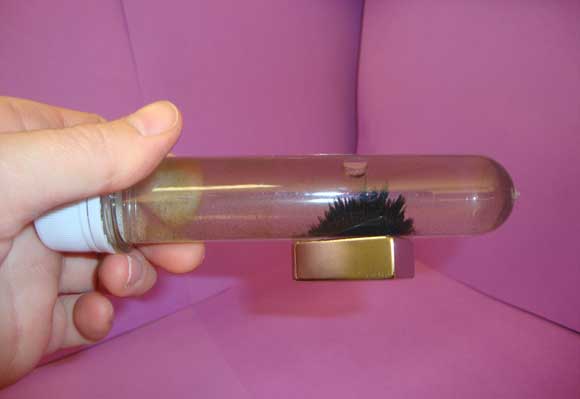Physics in a Jar: Make Your Own Ferrofluid

Is it a miniature porcupine? No! It’s ferrofluid.
What you Need
- Iron filings (can be ordered here, or extracted from your cereal – just follow this Physics@Home)
- A clear plastic water bottle or test-tube with cap
- Powerful Magnet (Neodymium works best)
- Water
What to Do
- Put two to three pinches of iron filings in the bottle or test tube
- Fill the bottle or test tube with water
- Cap the bottle or test tube
- Allow water to settle
- Place magnet on outside of bottle or test tube and watch what happens to the iron filings!
What’s Going On?
Iron is a very peculiar metal. Unlike most metals (for example,gold or aluminum), iron becomes magnetized in the presence of other magnets. To really understand how this happens first you need to know how magnets work.
Imagine that you have the superpower “microscope vision,” where you can see all the tiniest particles inside anything. When you look at a magnet you will see particles that have two ends, one end that we call north and the other end that we call south. Some people also call them positive and negative ends or poles. These ends have special properties where they attract the opposite type of pole and repel the same type of pole. For example, a north end will be attracted to a south end or a positive end will be attracted to a negative end. If two north ends are near each other they will be repelled (pushed apart) the same goes for two south ends, two negatives, or two positives. This explains why magnets sometimes stick together and other times repel each other. Radiating from each end is what's called a magnetic field which is invisible extending out and interacting with things that can be magnetized.
Iron filings are just teeny-tiny specks of iron, but remember that iron is special. When it is near a magnet the particles that make up the teeny-tiny specks of iron temporarily become magnets. The magnet induces (forces) the particles in the iron to orient themselves (go into a position) where the north and south poles all line up the same. This then makes each iron filing act as though they are little magnets! If you look carefully you can see that the teeny-tiny iron specks line up in the shape of the field around the magnet.
Traditionally, ferrofluid is made up of nanosized (that’s REALLY small!) iron oxide particles suspended in an oily liquid. The ferrofluid that you made doesn’t have nanosized iron particles or an oil base, but it acts very similar to how ferrofluid behaves. To watch how ferrofluid is used to create art check out this video.
Try This!
- Change the orientation of the magnet. How does this affect the pattern of the iron filings?
- If you repeat the experiment without the water, do you get the same effect?
More Information











